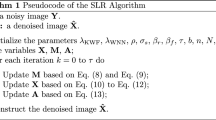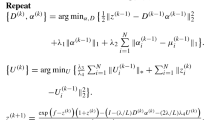Abstract
Low-rank matrix recovery (LRMR) has a wide range of applications in computer vision. In recent years, the rank residual constraint (RRC) model, which aims to approximate the underlying low-rank matrix via minimizing the rank residual, has provided a new idea for LRMR. Different from the RRC model which employs \(l_1\) norm as the regularization term, this paper exploits the weighted Schatten p-norm as the regularizer for the rank residual to obtain a new rank minimization model, namely the rank residual constraint model with adaptive weighted Schatten p-norm (SRRC). The proposed SRRC considers the importance of different rank residual components and gives better approximation to the original low-rank assumption. In the SRRC model, the adaptive p-values can vary with the sparsity of the rank residuals and different weights are assigned to different rank residuals. Thus, the proposed SRRC not only improves the sparsity of the rank residuals but also alleviates the over-penalty of the large singular values. We analyze the solution of SRRC model and prove that its global optimum can be efficiently solved by the generalized soft thresholding algorithm (GST). Extensive experimental results demonstrate that the proposed algorithm achieves favorable performance compared to many popular or state-of-the-art image denoising methods in terms of both objective and visual perception.






Similar content being viewed by others
Data Availability Statement
The data that support the findings of this study are openly available on the website https://github.com/zt9877/SRRC.git.
References
F. Albu, I. Caciula, Y. Li, Y. Wang, The \(l_p\)-norm proportionate normalized least mean square algorithm for active noise control, 2017. 21st International Conference on System Theory, Control and Computing (ICSTCC), pp. 396–400 (2017)
A. Buades, B. Coll, J.M. Morel, A non-local algorithm for image denoising, 2005 IEEE Computer Society Conference on Computer Vision and Pattern Recognition (CVPR’05), pp. 60–65 (2005)
J.F. Cai, E.J. Cand\(\grave{e}\)s, Z. Shen, A singular value thresholding algorithm for matrix completion. SIAM J. Optim. 20(4), 1956–1982 (2010)
E.J. Cand\(\grave{e}\)s, M.B. Wakin, S.P. Boyd, Enhancing sparsity by reweighted 1 minimization. J. Fourier Anal. Appl. 14(5), 877–905 (2007)
S.G. Chang, Y. Bin, M. Vetterli, Adaptive wavelet thresholding for image denoising and compression. IEEE Trans. Image Process. 9(9), 1532–1546 (2000)
K. Dabov, A. Foi, V. Katkovnik, K. Egiazarian, Image denoising by sparse 3-d transform-domain collaborative filtering. IEEE Trans. Image Process. 16(8), 2080–2095 (2007)
W. Dong, G. Shi, X. Li, Nonlocal image restoration with bilateral variance estimation: a low-rank approach. IEEE Trans. Image Process. 22(2), 700–711 (2013)
W. Dong, L. Zhang, G. Shi, X. Li, Nonlocally centralized sparse representation for image restoration. IEEE Trans. Image Process. 22(4), 1620–1630 (2013)
D.L. Donoho, For most large underdetermined systems of linear equations, the minimal L1-norm solution is also the sparsest solution. Commun. Pure Appl. Math. 59(6), 797–829 (2006)
A. Eriksson ,A. van den Hengel, Efficient computation of robust low-rank matrix approximations in the presence of missing data using the L1 norm, in 2010 IEEE Computer Society Conference on Computer Vision and Pattern Recognition, pp. 771–778 (2010)
M. Fazel, H. Hindi ,S. P. Boyd, A rank minimization heuristic with application to minimum order system approximation, Proceedings of the 2001 American Control Conference, Vol. 6, pp. 4734–4739 (2001)
S. Gu, L. Zhang, W. Zuo et al., Weighted nuclear norm minimization and its applications to low level vision. Int. J. Comput. Vision 121, 183–208 (2016)
S. Gu, L. Zhang, W. Zuo, et al., Weighted nuclear norm minimization with application to image denoising, in 2014 IEEE Conference on Computer Vision and Pattern Recognition, pp. 2862–2869 (2014)
Q. Guo, C. Zhang, Y. Zhang, H. Liu, An efficient svd-based method for image denoising. IEEE Trans. Circuits Syst. Video Technol. 26(5), 868–880 (2016)
M. Gonzalez-Lee et al., Exploring the cross-correlation as a means for detecting digital watermarks and its reformulation into the fractional calculus framework. IEEE Access 6, 71699–71718 (2018)
X. Jia, X. Feng, W. Wang, Rank constrained nuclear norm minimization with application to image denoising. Signal Process. 129, 1–11 (2016)
J.M. Keller, M.R. Gray, J.A. Givens, A fuzzy K-nearest neighbor algorithm. IEEE Trans. Syst. Man Cybern. 15(4), 580–585 (1985)
Y. Kong, M. Shao, K. Li, Y. Fu, Probabilistic low-rank multitask learning. IEEE Trans. Neural Netw. Learn. Syst. 29(3), 670–680 (2018)
J.E. Lav\(\acute{i}\)n-Delgado, J.E. Sol\(\acute{i}\)s-P\(\acute{e}\)rez, J.F. G\(\acute{o}\)mez-Aguilar, et al. (2020) A new fractional-order mask for image edge detection based on caputo-fabrizio fractional-order derivative without singular kernel. Circuits Syst. Signal Process. 39, 1419–1448
J.E. Lav\(\acute{i}\)n-Delgado, J. E. Sol\(\acute{i}\)s-P\(\acute{e}\)rez, J. F. G\(\acute{o}\)mez-Aguilar, et al., Image edge detection using fractional conformable derivatives in liouville-caputo sense for medical image processing, in Fractional Calculus in Medical and Health Science, pp. 1–54, CRC Press (2020)
Y. Li, Z. Pan, D. Du et al., Adaptive thresholding HOSVD with rearrangement of tensors for image denoising. Multimed. Tools Appl. 79(11), 19575–19593 (2020)
L. Li, S. Xiao, Y. Zhao, Joint group and residual sparse coding for image compressive sensing. Neurocomputing 405, 72–84 (2020)
Y. Li, Y. Wang, F. Albu, Sparse channel estimation based on a reweighted least-mean mixed-norm adaptive filter algorithm, in Signal Processing Conference. IEEE (2016)
X. Liao, H. Li, L. Carin, Generalized alternating projection for weighted-2,1 minimization with applications to model-based compressive sensing. SIAM J. Imag. Sci. 7(2), 797–823 (2014)
Z. Lin, M. Chen, Y. Ma, The augmented Lagrange multiplier method for exact recovery of corrupted low-rank matrices. Control Systems Laboratory (2010)
Z. Lin, A. Ganesh, J. Wright, L. Wu, M. Chen, Y. Ma, Fast convex optimization algorithms for exact recovery of a corrupted low-rank matrix, in Proc. CAMSAP, pp. 1–8 (2009)
W. Liu, W. Lin, Additive white gaussian noise level estimation in svd domain for images. IEEE Trans. Image Process. 22(3), 872–883 (2013)
J. Mairal, F. Bach, J. Ponce, et al., Non-local sparse models for image restoration, 2009 IEEE 12th International Conference on Computer Vision, pp. 2272–2279 (2009)
L. Mirsky, A trace inequality of john von neumann. Monatshefte f\(\ddot{u}\)r Mathematik, 79(4), 303–306 (1975)
S. Osher, M. Burger, D. Goldfarb et al., An iterative regular-ization method for total variation-based image restoration. SIAM J. Multiscale Model. Simul. 4(2), 460–489 (2005)
A. Rajwade, A. Rangarajan, A. Banerjee, Image denoising using the higher order singular value decomposition. IEEE Trans. Pattern Anal. Mach. Intell. 35(4), 849–862 (2012)
J.E. Solis-Perez, J. F. Gomez-Aguilar, R. F. Escobar-Jimenez, et al. (2019) Blood vessel detection based on fractional Hessian matrix with non-singular Mittag-Leffler Gaussian kernel. Biomed. Signal Process. Control. 54, 101584.1–101584.21
Y. Xie, S. Gu, Y. Liu, W. Zuo, W. Zhang, L. Zhang, Weighted schatten \(p\) -norm minimization for image denoising and background subtraction. IEEE Trans. Image Process. 25(10), 4842–4857 (2016)
Z. Xu, X. Chang, F. Xu, H. Zhang, \(L_{1/2}\) regularization: a thresholding representation theory and a fast solver. IEEE Trans. Neural Netw. Learn. Syst. 23(7), 1013–1027 (2012)
J. Xu, L. Zhang, W. Zuo, D. Zhang, X. Feng, Patch group based nonlocal self-similarity prior learning for image denoising, 2015 IEEE International Conference on Computer Vision (ICCV), pp. 244–252 (2015)
X. Yuan, J. Yang, Sparse and low-rank matrix decomposition via alternating direction methods. Pac. J. Optim. 9(1), 167–180 (2013)
Z. Zha, X. Yuan, B. Wen, J. Zhou, J. Zhang, C. Zhu, A benchmark for sparse coding: when group sparsity meets rank minimization. IEEE Trans. Image Process. 29, 5094–5109 (2020)
Z. Zha, X. Yuan, B. Wen, J. Zhang, J. Zhou, C. Zhu, Image restoration using joint patch-group-based sparse representation. IEEE Trans. Image Process. 29, 7735–7750 (2020)
Z. Zha, X. Yuan, B. Wen, J. Zhou, J. Zhang, C. Zhu, From rank estimation to rank approximation: rank residual constraint for image restoration. IEEE Trans. Image Process. 29, 3254–3269 (2020)
Z. Zha, X. Yuan, B. Wen, J. Zhou, C. Zhu, Group sparsity residual constraint with non-local priors for image restoration. IEEE Trans. Image Process. 29, 8960–8975 (2020)
J. Zhang, D. Zhao, W. Gao, Group-based sparse representation for image restoration. IEEE Trans. Image Process. 23(8), 3336–3351 (2014)
T. Zhou, D. Tao, Godec: Randomized low-rank and sparse matrix decomposition in noisy case, in Proc. 28th ICML, pp. 33–40 (2011)
W. Zuo, D. Meng, L. Zhang, X. Feng, D. Zhang, A generalized iterated shrinkage algorithm for non-convex sparse coding, in 2013 IEEE International Conference on Computer Vision, pp. 217–224 (2013)
Acknowledgements
The authors would like to thank editor and anonymous reviewers who gave valuable suggestion that has helped to improve the quality of the paper. Tao Zhang acknowledges the support by the National Natural Science Foundation of China under Grant 61701004, the Excellent Young Talents Fund Program of Higher Education Institutions of Anhui Province under Grant gxyq2021178 and the Open Fund of Key Laboratory of Anhui Higher Education Institutes under Grant CS2021-07. Xutao Mo acknowledges the support by the University Natural Science Research Project of Anhui Province of China under Grant KJ2020A0238 and the Excellent Young Talents Fund Program of Higher Education Institutions of Anhui Province under Grant gxyq2022014.
Author information
Authors and Affiliations
Contributions
Conceptualization: [Tao Zhang]; Methodology: [Tao Zhang]; Formal analysis and investigation: [Di Wu]; Writing–original draft preparation: [Di Wu, Tao Zhang]; Writing–review and editing: [Tao Zhang]; Funding acquisition: [Tao Zhang, Xutao Mo]; Resources: [Tao Zhang]; Supervision: [Tao Zhang, Xutao Mo]; Validation: [Di Wu, Xutao Mo]; Visualization:[Di Wu].
Corresponding author
Ethics declarations
Conflict of interest
We declare that we have no financial and personal relationships with other people or organizations that can inappropriately influence our work, there is no professional or other personal interest of any nature or kind in any product, service and/or company that could be construed as influencing the position presented in, or the review of, the manuscript entitled “The Rank Residual Constraint Model with Weighted Schatten p-Norm Minimization for Image Denoising”.
Additional information
Publisher's Note
Springer Nature remains neutral with regard to jurisdictional claims in published maps and institutional affiliations.
Rights and permissions
Springer Nature or its licensor (e.g. a society or other partner) holds exclusive rights to this article under a publishing agreement with the author(s) or other rightsholder(s); author self-archiving of the accepted manuscript version of this article is solely governed by the terms of such publishing agreement and applicable law.
About this article
Cite this article
Zhang, T., Wu, D. & Mo, X. The Rank Residual Constraint Model with Weighted Schatten p-Norm Minimization for Image Denoising. Circuits Syst Signal Process 42, 4740–4758 (2023). https://doi.org/10.1007/s00034-023-02330-5
Received:
Revised:
Accepted:
Published:
Issue Date:
DOI: https://doi.org/10.1007/s00034-023-02330-5




